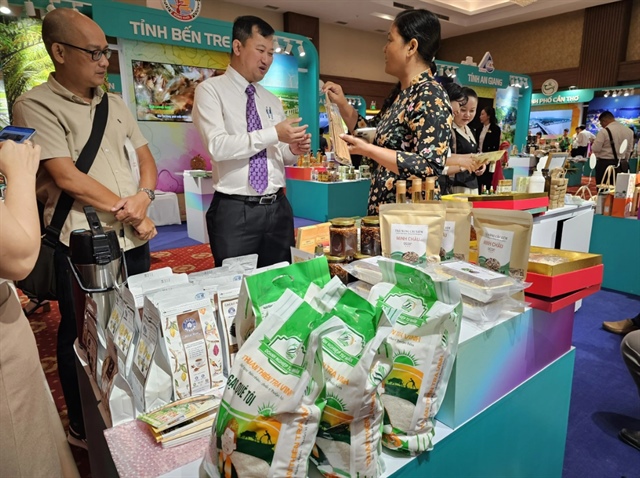Joint efforts in branding Vietnamese rice
Joint efforts in branding Vietnamese rice
Growing high-quality rice while building a reputable rice brand is a long journey, but several businesses and cooperatives have succeeded in branding Vietnamese rice after years of sustained efforts.

Many localities in the Mekong Delta region of Vietnam have been building rice brands. This picture shows the Que Toi rice in Tra Vinh Province on display at a Ho Chi Minh City-Mekong Delta cooperation conference in November 2024. Photo: C.Q. / Tuoi Tre |
The demand for tasty and recognizable rice among residents in major cities like Ho Chi Minh City and Hanoi is high, prompting rice processing and production facilities in the Mekong Delta region, dubbed Vietnam’s hub of rice, to invest more in branding.
In 2022, the popular ‘Gao Huyet Rong’ (Red Rice) brand in Dong Thap Province won third prize in a provincial rice competition.
Le Van Dau, known as Nam Dau, a resident of Phu Thanh A Commune in Tam Nong District, successfully hybridized a strange rice variety and named it Huyet Rong.
In 2020, his rice variety got a certificate for brand registration, and a year later, Dau spent over VND700 million (US$27,640) building a rice mill to expand a production line.
He said that a 10-hectare paddy field focused on the red rice variety, and was cultivated safely using compost.
Do Minh Hoang, deputy head of the Infrastructure and Economic Division in Tam Nong District, said Nam Dau’s facility is a typical business.
The facility has two products meeting the three-star OCOP (One Commune, One Product) standard, and another certified as a province-level outstanding rural industrial product.
The district is seeking approval from the provincial Department of Industry and Trade to allocate industrial promotion funds for the facility to purchase grinding and packaging machines valued at VND230 million ($9,065).
The district has proposed that the provincial Department of Science and Technology assist the factory in setting up a closed production line to improve the production of red rice powder, Hoang said.
Another locality in the delta, Ca Mau, is cultivating some 38,000 hectares of the Lua Tom (Shrimp Rice) rice variety, which has gained high popularity.
Farmers in several districts of the province take advantage of saline water and freshwater seasons in a year to rotate rice and shrimp farming on the same fields. Therefore, the Lua Tom rice brand was established.
Le Van Mua, chairman of the Tri Luc Rice-Shrimp Production Cooperative in Thoi Binh District, emphasized that building a strong rice brand is a time-intensive process. It requires consistent quality over the long term and a product that stands out from the competition.
"With this approach, Tri Luc Cooperative has developed Hoang Yen, an organic rice brand that meets the three-star OCOP benchmark," Mua said.
Vietnamese rice quality prevails
Le Van Den, a resident of Tan Loc Bac Commune in Thoi Binh District and a participant in the Lua Tom rice variety production, said that adopting proper organic rice cultivation techniques boosts yields by about 10 percent compared to traditional methods.
It also increases the selling price by 15 percent in comparison with conventionally farmed rice.
Organic cultivation reduces costs as it eliminates the need for pesticides and chemicals.
"One hectare of organic rice cultivation yields an average of eight metric tons of rice per year," Den said. "Unhusked rice is purchased at VND 1,500 [$0.06] per kilogram, significantly higher than the price of traditionally grown unhusked rice."
Truong Sy Ba, chairman of Tan Long Group JSC, noted that since the launch of the A An rice brand in July 2019, it has gained strong consumer trust.
While counterfeit versions of A An rice are widespread in the local market, only the packaging is imitated.
"The quality of the rice itself cannot be replicated," Ba asserted.
The A An rice brand includes the ST21, ST24, ST25, Japonica, and Dai Thom 8 rice varieties, offering the local market up to 60,000 metric tons annually.
To successfully build a rice brand, the company has standardized rice quality and controlled all relevant cultivation steps from sowing seeds, harvesting, drying, packaging to storing.
Ba explained that the effort to create the rice brand was driven by increasing customer demand for high-quality and safe grains.
More and more people are favoring rice of clear origin.
“This is an inevitable trend, so building a rice brand will be supported by customers. Despite several difficulties and challenges during the rice branding journey, it is sure that the brand will bring multiple benefits,” he said.
Nam Dau said the red rice is cultivated on 10 hectares for 2-3 crops annually, with yields reaching up to 60,000 metric tons.
The red rice is priced at VND30,000 ($1.18) per kilogram, up to VND12,000 ($0.48) higher than other varieties.
In addition, various products made out of the red rice such as rice powder are sold at high prices.
Phan Hoang Vu, director of the Ca Mau Department of Agriculture and Rural Development, stated that in recent years, the province has actively supported the development of organic Lua Tom rice.
"With high-quality seeds and improved cultivation techniques, the rice is now tastier and safer," Vu said.
























